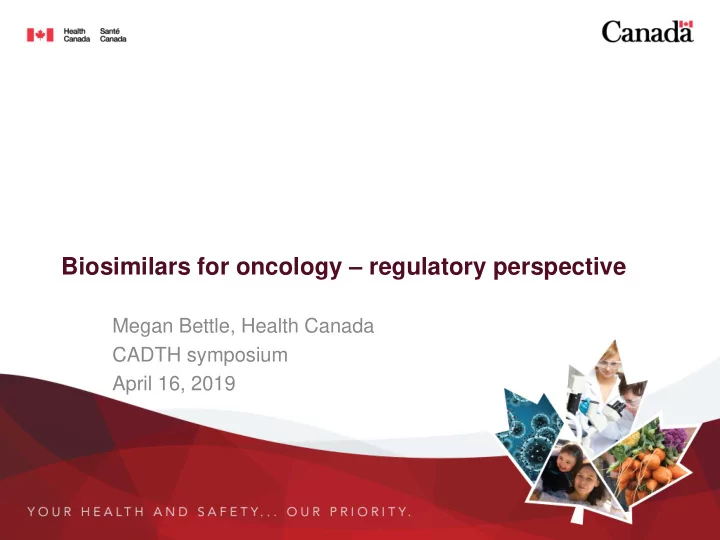

Biosimilars for oncology – regulatory perspective Megan Bettle, Health Canada CADTH symposium April 16, 2019
Biosimilars • A biologic drug that enters the market subsequent to a version previously authorized in Canada, and with demonstrated similarity to a reference biologic drug (RBD) • Biosimilars are considered “new drugs” in Canada (F&DR C.08.001), and are regulated in the same way as a “new drug” once they receive market authorization, including post-market safety reporting requirements • No clinically meaningful differences in efficacy, safety and/or immunogenicity • The biosimilar may receive all or some therapeutic indications of the reference product – in general, this depends on indications sought by the sponsor (ie, submission-driven) • Why are biosimilars not identical to their reference? • Production in living organisms produces a variable product • Manufacturing process will differ from the innovator 2
Drug submission content requirements Comparisons to be made to the reference product: Analytical/Structural analyses Human clinical trials, including: • Primary, secondary, tertiary structure • Comparative PK/PD studies • Protein modifications • Safety (including immunogenicity) and efficacy (preferably equivalence rather non-inferiority) where • Glycosylation needed to address residual uncertainty about • Purity comparability • Biological Activity Key oncology endpoints could include: • Overall response rate (primary) Functional analyses • • Pathological complete response (primary) in vitro, cell-based studies • Progression-free survival (secondary) • Overall survival (secondary) Non-clinical studies, including: • • Minimal residual disease status (secondary) Receptor binding, cell-based assays • Animal PK/PD, repeat dose toxicity 3
Switching – HC Perspective • In the context of biosimilar use, switching generally refers to a controlled change from a reference biologic drug to a biosimilar • Patients and healthcare providers can have confidence that biosimilars are safe and effective for the authorized indications listed in the Product Monograph • Well-controlled switches from reference biologic drug to biosimilar in an authorized indication are considered acceptable and no differences in clinical outcomes are expected • For questions related to changing from one biologic drug (innovator or biosimilar) to another, patients should speak to their doctor. 4
HC Authorized Biosimilars 2017 2009 • Erelzi (etanercept) • Omnitrope ( somatropin ) – Additional indications in 2019 – additional indications in 2015 • Admelog (insulin lispro) 2014 • Renflexis (infliximab) • Inflectra (infliximab) 2018 – Additional indications in 2016 • Lapelga (pegfilgrastim) • Remsima (infliximab) • Mvasi (bevacizumab) – Additional indications in 2016 • Hadlima (adalimumab) 2015 • Fulphila (pegfilgrastim) • Basaglar (insulin glargine) 2019 • Grastofil (filgrastim) • Rituximab 2016 Upcoming: • Brenzys (etanercept) • Trastuzumab • Others 5
Intellectual Property Hold • Upon completion of the review of a submission, authorization of the biosimilar will not be issued until all matters under the Patented Medicines (Notice of Compliance) Regulations have been resolved. Until this time, the biosimilar submission is placed on “Intellectual Property Hold". • Information on biosimilar submissions under review is now made available: https://www.canada.ca/en/health-canada/services/drug-health-product-review- approval/submissions-under-review.html#_Submissions_currently_under 6
Improving Access to Biosimilars • The number of biosimilar submissions is expected to continue increasing as patents/data protection for leading biologics expire • Almost every submission has a pre- submission filing meeting and possibly pre- clinical trial application meetings (scientific and regulatory advice) • Increased interactions between regulator and sponsor for many biosimilar submissions – new pathway, new companies, and companies new to biologics manufacturing • Improving access to biosimilars is one sub- project under Health Canada’s Regulatory Review of Drugs and Devices (R2D2) Initiative – Focus on building capacity (hiring and training new staff) to meet the demand 7
Naming of Biologic Drugs • February 14, 2019 – Decision to identify biologic drugs (including biosimilars) by their unique brand name and non-proprietary name – without the addition of a suffix – Recommend the use of both names (brand name and INN) throughout the medication use process so that biologic drugs can be distinguished by the Brand name where more than one version exists • All biologics continue to have a unique D rug I dentification N umber (DIN) – Distinguishes key characteristics of the product (e.g., brand name, manufacturer name, medicinal ingredients(s), strength(s), dosage form, route of administration). • Product-specific identifiers, including brand name, non-proprietary name, DIN and lot number should be included in adverse drug reaction reports to facilitate the traceability of an adverse reaction to a specific suspect drug product. 8
Opportunities • HC has increased review staff to support expected increases in numbers of biosimilar drug submissions • Continued partnership between regulator, health technology assessment, and other partners across the healthcare system will support availability of biosimilars • Other ongoing activities, including enhanced use of real world evidence, will support ongoing monitoring for safety and effectiveness (as for all drugs) 9
Recommend
More recommend